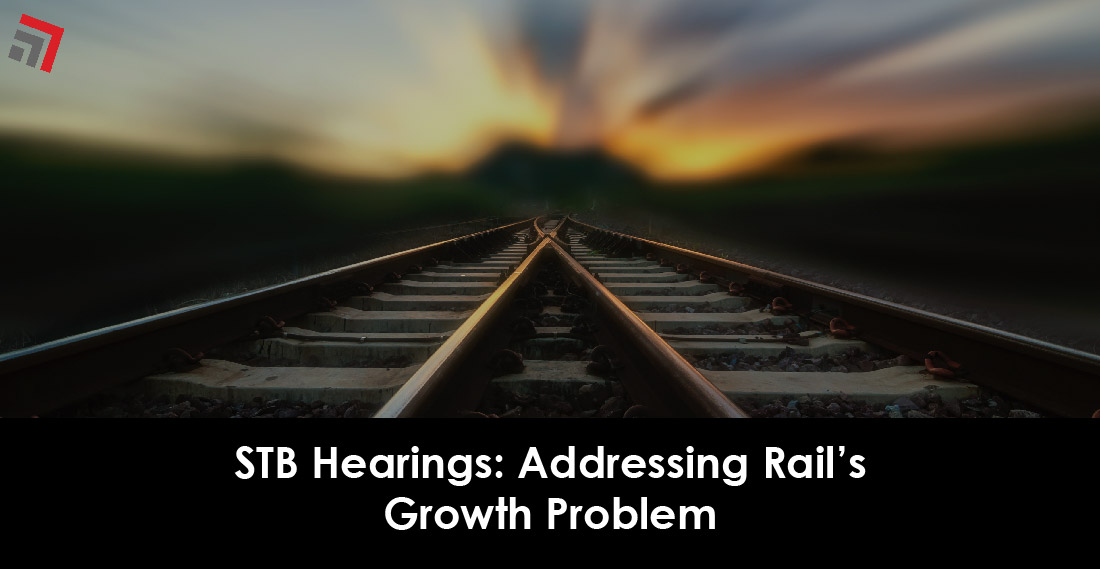There was a day when the train was America’s transportation sweetheart. That day certainly wasn’t yesterday. Definitely not five—ten—twenty—years ago. And, most certainly and most definitely not since the mid-century advent of the U.S. interstate system.
The prime of the railroad is ancient history, its likeness stoically documented in frizzy sepia frames. The once domineering mode, the first to forge commercial links between the U.S. coasts, is now having its viability questioned by inquisitive regulators peering over sepia daises. The billion-dollar question: when will the rail industry make a comeback?
Railroad executives, stakeholders speak at hearing
On Monday, the Surface Transportation Board, an independent federal agency which oversees regulation of the rail industry, held its first day of hearings focused around rail’s lack of growth, especially in its competition for freight business against trucking, a bout the latter has dominated.
In what’s designed to be a forum where stakeholders converge and share uncomfortable truths, railroad executives skewed in another direction. Class I railroads reminded those in attendance of their successes and advantages to customers, whether through expanded intermodal offerings or cheaper freight rates (compared to truckload). These odes were even paired with visual presentations: slides with branded infographics, vague business-related platitudes (like strategic development), and strange proclamations. Growth is embedded in our DNA, wrote one railroad on a slide.
There was a palpable clash between braggart marketing and deflating statistics, the latter which others at the hearing shared, much to the probable discomfort of executives. An analyst panel outlined the complexities behind the industry’s stunt in growth, including its loss of market share to trucks.
Industry consultant Adriene Bailey, who was once called Dr. Doom following a harsh telling of truth at a conference in 2021, maintained her stance that rail is lagging behind its surface counterpart. She noted that rail tonnage is down eight percent from 2017 through 2023, while truck tonnage increased three percent over the same period. Additionally, she noted that the U.S. DOT forecasts rail market share will drop by four percent by 2050, albeit a conservative figure in Bailey’s mind as she asserts it understates the potential decline due to freight shifting to trucks.
To outsiders, four percent may not sound like much, but for an industry that reaps billions in revenue each year, it’s a steep price to pay. Bailey claimed if the railroads allow the decline, it will cost the industry $476 billion in revenue and $128 billion in operating income.
Next up, Rick Paterson, an investment analyst, noted that combined freight volumes for the four largest U.S. railroads—BNSF, CSX, Norfolk Southern, and Union Pacific—fell 7 percent between 2000 and 2023. Within that same period, Paterson added that the country’s economy grew 50 percent and truck tonnage grew 43 percent. In explaining the declines, Paterson pointed the blame at the railroads, alleging that the companies exploit shipper-customers through their pricing power and provide unreliable, outdated service.
Byron Porter, a former shipper and current executive of a major manufacturer, said railroads are stuck in a profitability strategy driven by the industry’s connections to Wall Street. Porter claims railroads can’t prioritize a growth strategy when their business interests are captive to the demands of the financial industry.
Aside from creating urgency to recapture lost business, Bailey also offered insights into how railroads can siphon back market share. She asserts the railroads must zero-in on shorter haul (less than 750 miles) intermodal business and capitalize on manufacturing growth in North America.
Service perspective: Rail’s future is challenged, but it’s still the right option for certain shippers
Whether it’s for lack of growth or lack of safety, the rail industry will remain scrutinized in the foreseeable future. It certainly warrants criticism. The mode had a testy service record over the last couple of years, including arbitrary embargoes and prolonged labor disputes, while it also raised concerns over its operating procedures following publicized derailments.
However, as we’ve emphasized on previous blogs, public scrutiny can overshadow the advantages of freight rail service. While it’s no longer the transportation monopoly it was during the Gilded Age, the railroad still carves out an important role in U.S. supply chains. While it’s best known for international intermodal movement between West Coast ports and Midwest cities, freight rail can actually work well for both international and domestic transportation. Mile to mile, it’s cheaper than truck which, in the case of a long-haul shipment, could save hundreds if not thousands of dollars.
But freight rail service has certain criteria you’d want to check beforehand. If the following makes sense in your supply chain, the mode is right for you!
- Shippers with lanes between two large cities that cover regional and/or cross-country distances (examples: Los Angeles to Chicago; Los Angeles to Dallas; Oakland to Nashville)
- Shippers and receivers whose pickup and drop off points are close (within 100 miles) to a rail ramp (located in port cities and select inland cities)
- Shippers with cargo that can book several days in advance and acknowledge the longer transit times of rail versus trucking (example: Transit between Los Angeles to Chicago ramps can take anywhere from ten to 20 days, while a long-haul trucking option typically takes half a week)




Recent Comments